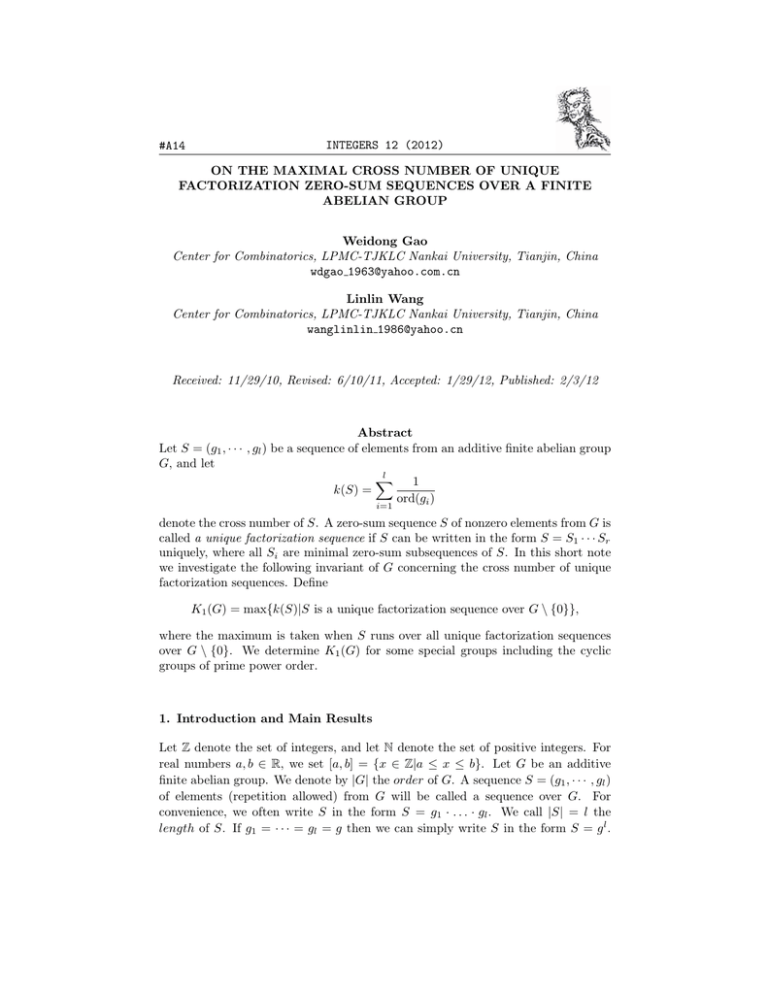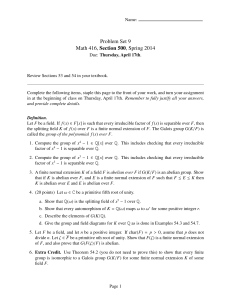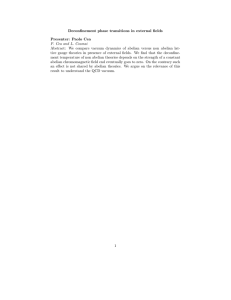INTEGERS 12 (2012) #A14 ON THE MAXIMAL CROSS NUMBER OF UNIQUE
advertisement

#A14
INTEGERS 12 (2012)
ON THE MAXIMAL CROSS NUMBER OF UNIQUE
FACTORIZATION ZERO-SUM SEQUENCES OVER A FINITE
ABELIAN GROUP
Weidong Gao
Center for Combinatorics, LPMC-TJKLC Nankai University, Tianjin, China
wdgao 1963@yahoo.com.cn
Linlin Wang
Center for Combinatorics, LPMC-TJKLC Nankai University, Tianjin, China
wanglinlin 1986@yahoo.cn
Received: 11/29/10, Revised: 6/10/11, Accepted: 1/29/12, Published: 2/3/12
Abstract
Let S = (g1 , · · · , gl ) be a sequence of elements from an additive finite abelian group
G, and let
l
!
1
k(S) =
ord(gi )
i=1
denote the cross number of S. A zero-sum sequence S of nonzero elements from G is
called a unique factorization sequence if S can be written in the form S = S1 · · · Sr
uniquely, where all Si are minimal zero-sum subsequences of S. In this short note
we investigate the following invariant of G concerning the cross number of unique
factorization sequences. Define
K1 (G) = max{k(S)|S is a unique factorization sequence over G \ {0}},
where the maximum is taken when S runs over all unique factorization sequences
over G \ {0}. We determine K1 (G) for some special groups including the cyclic
groups of prime power order.
1. Introduction and Main Results
Let Z denote the set of integers, and let N denote the set of positive integers. For
real numbers a, b ∈ R, we set [a, b] = {x ∈ Z|a ≤ x ≤ b}. Let G be an additive
finite abelian group. We denote by |G| the order of G. A sequence S = (g1 , · · · , gl )
of elements (repetition allowed) from G will be called a sequence over G. For
convenience, we often write S in the form S = g1 · . . . · gl . We call |S| = l the
length of S. If g1 = · · · = gl = g then we can simply write S in the form S = g l .
2
INTEGERS: 12 (2012)
For every g ∈ G, let vg (S) denote the number of the times that g occurs in S. Let
def
T = gi1 · · · git be a subsequence of S. We call IT = {i1 , · · · , it } the index set of T .
We denote by ST −1 the subsequence of S with the index set {1, · · · , l} \ IT . Let
T1 and T2 be two subsequences of S. By T1 ∩ T2 we denote the sequence with the
index set IT1 ∩ IT2 . We say T1 and T2 are disjoint if IT1 ∩ IT2 = ∅, and denote by
T1 T2 the sequence with the index set IT1 ∪ IT2 . We identify two subsequences S1
and S2 of S if and only if IS1 = IS2 .
"l
Let σ(S) = i=1 gi ∈ G denote the sum of S. We call the sequence S
• a zero-sum sequence if σ(S) = 0,
• a zero-sum free sequence if S contains no nonempty zero-sum subsequence,
• a minimal zero-sum sequence if S is a nonempty zero-sum sequence and S
contains no proper zero-sum subsequence.
Every map of abelian groups φ : G → H extents to a map from the sequences
over G to the sequences over H by φ(S) = φ(g1 )·. . .·φ(gl ). If φ is a homomorphism,
then φ(S) is a zero-sum sequence if and only if σ(S) ∈ ker(φ).
Let D(G) be the Davenport constant of G which is the smallest integer d such that
every sequence of d elements from G is not zero-sum free. D(G) can also be defined
equivalently as the maximal length of the minimal zero-sum sequences over G.
Let
l
!
1
k(S) =
ord(g
i)
i=1
denote the cross number of S. Define
K(G) = max{k(S)|S is a minimal zero-sum sequence over G},
the maximum taken when S runs over all minimal zero-sum sequences over G.
The following invariant N1 (G) was introduced by Narkiewicz in 1979 [13] which
like D(G) and K(G) plays an important role in the study of non-unique factorization
problems in algebraic number theory (see [7], [12], [16] and [6]). Let S be a zero-sum
sequence over G \ {0}, i.e., S is a zero-sum sequence of non-zero elements from G.
Clearly, S can be written in the form S = S1 · · · Sr with all Si being minimal zerosum subsequences of S, and we call S = S1 · · · Sr an irreducible factorization of S.
We identify two irreducible factorizations S = S1 · · · Sr and S = T1 · · · Tm if and only
if m = r, and there is a permutation τ on {1, . . . , r} such that Si = Tτ (i) for every i ∈
[1, r]. A zero-sum sequence S over G\{0} is called a unique factorization se-quence if
S has only one irreducible factorization. Narkiewicz constant N1 (G) is the maximal
length of the unique factorization sequences over G \ {0}. Unique factorization
sequences and therefore N1 (G) can also be formulated in terms of the concept of
“type” just like what Geroldinger and Hater-Koch did in ([6], Chapter 9).
3
INTEGERS: 12 (2012)
For |G| > 1, define
K1 (G) = max{k(S)|S is a unique factorization sequence over G \ {0}}
where the maximum is taken when S runs over all unique factorization sequences
over G \ {0}, and let K1 (G) = 0 if |G| = 1.
The study of the cross number has attracted a lot of attention since it was
introduced by Krause [8] in 1984 (for example, see [5], [9], [2], [6], [10] and [11]).
Every nontrivial finite abelian group G can be written uniquely in the form
i
G = ⊕ri=1 ⊕tj=1
Cpi eij , where p1 , · · · , pr are distinct primes. Set
K1∗ (G) =
ti
r !
!
i=1 j=1
e
e
pi ij − 1
e −1 ,
pi ij − pi ij
and let K1∗ (G) = 0 if |G| = 1.
It is not difficult to see that K1 (G) ≥ K1∗ (G) holds for all finite abelian groups
G (see Proposition 3 in Section 2). We propose the following conjecture.
Conjecture 1. K1 (G) = K1∗ (G) holds for any finite abelian group G.
In this paper we shall verify Conjecture 1 for some special groups by showing the
following main result.
Theorem 2. Let p be a prime, and let G be a finite abelian group. Then, K1 (G) =
K1∗ (G) if G is one of the following groups:
(1) G = Cpm with m ∈ N;
(2) G = Cpq with q a prime;
(3) G = C2r with r ∈ N;
(4) G = C3r with r ∈ N;
(5) G = Cp2 .
2. A Lower Bound for K1 (G)
Proposition 3. Let G be a finite abelian group. (1) If G = G1 ⊕ G2 for some finite
abelian groups G1 and G2 then K1 (G) ≥ K1 (G1 ) + K1 (G2 ); (2) K1 (G) ≥ K1∗ (G)
holds for any finite abelian group G.
Proof. If one of G, G1 and G2 is trivial then the proposition holds trivially. So, we
may assume that none of G, G1 and G2 is trivial.
(1). Let S1 = a1 · · · au be a unique factorization sequence over G1 with k(S1 ) =
K1 (G1 ), and Let S2 = b1 · · · bv be a unique factorization sequence over G2 with
4
INTEGERS: 12 (2012)
k(S2 ) = K1 (G2 ). Let 0G1 denote the identity element of G1 , and let 0G2 denote
the identity element of G2 . Let
S1# = (a1 , 0G2 )(a2 , 0G2 ) · · · (au , 0G2 ) and S2# = (0G1 , b1 )(0G1 , b2 ) · · · (0G1 , bv ).
Then both S1# and S2# are sequences over G = G1 ⊕ G2 with |S1# | = |S1 |, |S2# | =
|S2 |, k(S1# ) = k(S1 ) and k(S2# ) = k(S2 ). Let S = S1# S2# . Clearly, S is a unique
factorization sequence over G. Therefore, K1 (G) ≥ k(S) = k(S1# ) + k(S2# ) = k(S1 ) +
k(S2 ) = K1 (G1 ) + K1 (G2 ).
(2). By (1), it suffices to prove K1 (G) ≥ K1∗ (G) for every cyclic group G of prime
power order. Let G = Cpm with p a prime, and let g be a generating element of G.
Let
S = g p−1 · ((1 − p)g) · (pg)p−1 · ((1 − p)pg) · · · (pm−2 g)p−1 · ((1 − p)pm−2 g) · (pm−1 g)p ,
i.e., S is the sequence with vpi g (S) = p − 1 and v(1−p)pi g (S) = 1 for every i ∈
[0, m − 2], and vpm−1 g (S) = p. Clearly, S is a unique factorization sequence. So,
m
1
∗
K1 (Cpm ) ≥ k(S) = 1 + p1 + · · · + pm−1
= pmp−p−1
m−1 = K1 (G).
3. Proof of Theorem 2
To prove Theorem 2 we need some preliminaries and we begin with a result of Olson
[15].
Let p be a prime, and let G be a finite abelian p-group. For g ∈ G, define
α(g) = pn where n is the largest integer such that g ∈ pn G = {pn x|x ∈ G}
(α(0) = ∞). Let S = g1 · . . . · gl be a sequence over G. Define
α(S) =
l
!
α(gi ).
i=1
Lemma 4. ([15]) Let p be a prime, and let G = Cpe1 ⊕ · · · ⊕ Cper . Let S = g1 · · · gk
"r
"r
be a sequence over G. If α(S) = i=1 α(gi ) ≥ 1 + i=1 (pei − 1), then S is not
zero-sum free.
Lemma 5. ([3]) Let S be a zero-sum sequence over G \ {0}. Then, the following
statements are equivalent.
(1) S is a unique factorization sequence;
(2) For any two zero-sum subsequences S1 and S2 of S we have that the intersection
S1 ∩ S2 is also a zero-sum sequence.
Let G be a finite abelian group. It is well known that either |G| = 1 or G can be
written uniquely in the form G = Cn1 ⊕ · · · ⊕ Cnr with 1 < n1 | · · · |nr . Narkiewicz
5
INTEGERS: 12 (2012)
[13] conjectured that N1 (G) = n1 + · · · + nr holds for any finite abelian group G.
This conjecture has been verified only for some very special groups. Some of these
groups are listed below and will be used in the proof of Theorem 2.
Lemma 6. ([14], [1], [4]) Let p be a prime. Then N1 (G) = n1 + · · · + nr if G is
one of the following groups
1. G = Cn with n ∈ N;
2. G = C2r ;
3. G = C3r ;
4. G = Cp2 .
Lemma 7. Let p be a prime, and let r be a positive integer. Then, N1 (Cpr ) = rp if
and only if K1 (Cpr ) = r.
Proof. Let G = Cpr . Since every nonzero element of G has order p, the result follows
from the definitions of N1 (G) and K1 (G).
Proof of Theorem 2. We start with the proof of (1). By Proposition 3, it suffices to
prove the upper bound.
We proceed by induction on m. If m = 1, let S = g1 · · · gk be a zero-sum sequence
over G \ {0} with k(S) = kp > 1. Since N1 (Cp ) = p we know that S is not a unique
factorization sequence. It follows that K1 (Cp ) = 1.
Now let m ≥ 2. Let S be a unique factorization zero-sum sequence over G∗ =
1
Cpm \ {0}. We need to show that k(S) ≤ 1 + p1 + · · · + pm−1
.
1
1
Assume to the contrary that k(S) > 1 + p + · · · + pm−1 . We shall derive a
contradiction. Write S in the form
ri
m #
#
S = g11 · · · g1r1 g21 · · · g2r2 · · · gm1 · · · gmrm =
gij
i=1 j=1
with gij ∈ Cpm and ord(gij ) = p for all i ∈ [1, m] and j ∈ [1, ri ]. Then
i
k(S) =
ri
m !
!
i=1 j=1
1
r1
rm
=
+ ··· + m.
ord(gij )
p
p
Therefore,
+ ··· +
> 1 + p1 + · · · +
above inequality with p we obtain
r1
p
rm
pm
r1 +
1
pm−1 .
Multiplying the two sides of the
r2
rm
1
1
+ · · · + m−1 > p + 1 + + · · · + m−2 .
p
p
p
p
Let φ be the canonical epimorphism from Cpm to Cpm /Cp . Let T = g11 · · · g1r1
$m $ri
and let S # = ST −1 . Then φ(S # ) = φ(ST −1 ) = i=2 j=1
φ(gij ) and
k(φ(S # )) =
r2
rm
1
1
+ · · · + m−1 > p − r1 + 1 + + · · · + m−2 .
p
p
p
p
6
INTEGERS: 12 (2012)
By multipling the two sides of the above inequality with pm−1 we obtain that
r2 pm−2 + r3 pm−3 + · · · + rm ≥ pm−1 (p − r1 + 1) + pm−2 + · · · + p + 1. Therefore,
α(φ(S # )) = r2 pm−2 + r3 pm−3 + · · · + rm ≥ pm−1 (p − r1 + 1) + pm−2 + · · · + p + 1.
Let t ≥ 0 be maximal such that there are disjoint subsequences S1 , . . . , St of S #
with σ(Si ) ∈ ker φ \ {0} for every i ∈ [1, t]. By the maximality of t we infer that
φ(Si ) is a minimal zero-sum sequence for each i ∈ [1, t]. It follows from Lemma 4
that α(φ(Si )) ≤ pm−1 for each i ∈ [1, t]. We assert that t+r1 ≥ p+1. Assume to the
"t
contrary that t+r1 ≤ p. Then, α(φ(S # (S1 · · · St )−1 )) = α(φ(S # ))− i=1 α(φ(Si )) ≥
pm−1 (p − r1 + 1) + pm−2 + · · · + p + 1 − (p − r1 )pm−1 ≥ pm−1 + pm−2 + · · · + p + 1. Let
S ## = S # (S1 · · · St )−1 . We just proved that α(φ(S ## )) ≥ pm−1 +pm−2 +· · ·+p+1. Let
rj## be the number of elements x(counted with multiple) of φ(S ## ) with ord(x) = pj
##
##
for every j ∈ [1, m − 1]. It follows that r1## pm−2 + · · · + rm−2
p + rm−1
= α(φ(S ## )) ≥
m−1
m−2
p
+p
+ · · · + p + 1. Therefore,
K(φ(S ## )) =
##
r##
rm−1
r1##
1
1
1
+ · · · + m−2
+
≥ 1 + + · · · + m−2 + m−1 .
m−2
m−1
p
p
p
p
p
p
By the induction hypothesis, we have K1 (φ(Cpm )) = K1 (Cpm−1 ) = 1 + p1 + · · · +
1
##
pm−2 . Therefore, φ(S ) is not a unique factorization sequence. By Lemma 5 there
exist two subsequences T1 , T2 of S ## such that both φ(T1 ) and φ(T2 ) are minimal
zero-sum sequences but φ(T1 ∩ T2 ) is not a zero-sum sequence over φ(G) = Cpm−1 .
Hence, T1 ∩T2 is not a zero-sum sequence over Cpm . Since S is a unique factorization
sequence, again by Lemma 5 we obtain that either σ(T1 ) ∈ ker φ \ {0}, or σ(T2 ) ∈
ker φ \ {0}, a contradiction to the maximality of t. This proves that t + r1 ≥ p + 1.
Since σ(φ(S(T S1 · · · St )−1 )) = 0, S(T S1 · · · St )−1 = R1 · · · R" with φ(Ri ) being
minimal zero-sum for each i ∈ [1, %]. By the maximality of t, σ(Ri ) = 0 for each
i ∈ [1, %]. It follows that both S(T S1 · · · St )−1 and T S1 · · · St are zero-sum sequences.
Now T σ(S1 ) · · · σ(St ) is a zero-sum sequence over Cp \ {0} and |T σ(S1 ) · · · σ(St )| =
r1 + t ≥ p + 1. By N1 (Cp ) = p we obtain that T σ(S1 ) · · · σ(St ) is not a unique
factorization sequence, and so neither is S, a contradiction.
We now prove (2). From Part (1) we may assume that p += q. It suffices to prove
the upper bound. Let S be a unique factorization sequence over Cpq \ {0}. We need
to show that k(S) ≤ 2. Assume to the contrary that k(S) > 2. Write S in the form
S = g11 · · · g1m g21 · · · g2n g31 · · · g3k
with
Then k(S) =
m
p
+
n
q
+
k
pq
p
ord(gij ) = q
pq
if i = 1
if i = 2
if i = 3.
> 2. Therefore,
mq + np + k ≥ 2pq + 1.
(1)
7
INTEGERS: 12 (2012)
Let T = g11 · · · g1m , and let φ be the canonical epimorphism from Cpq to Cpq /Cp .
Then
φ(ST −1 ) = φ(g21 ) · · · φ(g2n )φ(g31 ) · · · φ(g3k )
−1
and k(φ(ST −1 )) = n+k
)) = 0.
q . Since σ(S) = 0, we infer that σ(φ(ST
Let t ≥ 0 be maximal such that there are disjoint subsequences S1 , . . . , St of ST −1
with σ(Si ) ∈ ker φ\{0} for every i ∈ [1, t]. By the maximality of t we infer that φ(Si )
is a minimal zero-sum sequence over φ(Cpq ) ∼
= Cq for each i ∈ [1, t]. It follows from
D(Cq ) = q that |Si | = |φ(Si )| ≤ q for each i ∈ [1, t]. As in Part (1) we obtain that
T σ(S1 ) · · · σ(St ) is a zero-sum sequence over Cp \{0}. If m+t ≥ p+1 > p = N1 (Cp )
then T σ(S1 ) · · · σ(St ) is not a unique factorization sequence, and so neither is S, a
contradiction. Therefore, m + t ≤ p.
If n ≥ q + 1, then by switching p for q and repeating the procedure above we can
derive a contradiction. Therefore, n ≤ q.
From Equation (1) we obtain that np + k − (p − m)q ≥ pq + 1. This together
with n ≤ q gives that k − (p − m)q > 0. Therefore, np + (k − (p − m)q)p >
np + k − (p − m)q ≥ pq + 1. Hence, n + k − (p − m)q ≥ q + 1.
Now we have that |S(T S1 · · · St )−1 | ≥ |S|−m−tq = n+k−tq ≥ n+k−(p−m)q ≥
q + 1 > q = N1 (Cq ). So, φ(S(T S1 · · · St )−1 ) is not a unique factorization sequence.
As in Part (1) we can derive a contradiction.
The proofs of (3)–(5) result follow from Lemma 6 and Lemma 7.
4. Concluding Remarks
For the general case we have the following result.
Proposition 8. Let G be a nontrivial finite abelian group, and p be the smallest
prime divisor of |G|. Then K1 (G) < ln |G| + p1 log2 |G|.
Proof. Let S be a unique factorization sequence over G \ {0}. Let S = S1 · · · St
be an irreducible factorization of S, where t ∈ N, and all S1 , . . . , St are minimal
zero-sum subsequences of S. Then we have |Si | ≥ 2 for every i ∈ [1, t]. By a result
of Narkiewicz (see [14], Proposition 6; or [1], Lemma 2), Πti=1 |Si | ≤ |G|. Therefore,
t ≤ log2 |G|.
For every i ∈ [1, t] we choose an element gi ∈ supp(Si ). Since S is a unique
factorization sequence, we infer that the sequence T = g1−1 S1 · · · gt−1 St is zero-sum
free. Now by a result of Geroldinger and Schneider [9], k(T ) ≤ ln |G|. Therefore,
k(S) = k(T ) +
t
!
i=1
1
1
log2 |G|
≤ ln |G| + t ≤ ln |G| +
.
ord(gi )
p
p
INTEGERS: 12 (2012)
8
Let G be a finite abelian group. It is easy to see that K(G) ≤ K1 (G) holds
for all nontrivial finite abelian groups. Unlike the Davenport constant D(G), the
exact values of K(G) for most of cyclic groups are not known. Also, very little is
known about the Narkiewicz constant N1 (G). So, at the moment we can’t expect
much results in the determining of K1 (G) since this is essentially involved in the
determining of K(G) and N1 (G).
Acknowledgments. This work was supported by the PCSIRT Project of the
Ministry of Science and Technology, and the National Science Foundation of China.
We would like to thank professor Yuanlin Li and the referee for their very useful
comments and suggestions.
References
[1] W. Gao, On a combinatorial problem connected with factorizations, Colloq. Math. 72 (1997),
251 – 268.
[2] W. Gao and A. Geroldinger, Zero-sum problems in finite abelian groups : a survey, Expo.
Math. 24 (2006), 337 – 369.
[3] W. Gao, A. Geroldinger and Q. Wang, A quantitative aspect of non-unique factorizations:
the narkiewicz constants, International Journal of Number Theory 7 (2011), 1463 – 1502.
[4] W. Gao, Y. Li and J. Peng, A quantitative aspect of non-unique factorizations: the
narkiewicz constants II, Colloq. Math. 124 (2011), 205 – 218.
[5] A. Geroldinger, The cross number of finite abelian groups, J. Number Theory 48 (1994),
219–223.
[6] A. Geroldinger and F. Halter-Koch, Non-Unique Factorizations. Algebraic, Combinatorial
and Analytic Theory, Pure and Applied Mathematics, vol. 278, Chapman & Hall/CRC,
2006.
[7] A. Geroldinger, F. Halter-Koch, and J. Kaczorowski, Non-unique factorizations in orders of
global fields, J. Reine Angew. Math. 459 (1995), 89 – 118.
[8] U. Krause, A characterization of algebraic number fields with cyclic class group of prime
power order, Math. Z. 186 (1984), 143 – 148.
[9] A. Geroldinger and R. Schneider, The cross number of finite abelian groups II, Europ. J.
Combinatorics 15 (1994), 399 – 118.
[10] A. Geroldinger and R. Schneider, On minimal zero sequences with large cross number, Ars
Combinatoria 46 (1997), 297 – 303.
[11] B. Girard, A new upper bound for the cross number of finite abelian groups, Israel J. Mathematics 172 (2009), 253 – 278.
[12] F. Halter-Koch, Chebotarev formations and quantitative aspects of non-unique factorizations, Acta Arith. 62 (1992), 173 – 206.
[13] W. Narkiewicz, Finite abelian groups and factorization problems, Colloq. Math. 42 (1979),
319 – 330.
[14] W. Narkiewicz and J. Śliwa, Finite abelian groups and factorization problems II, Colloq.
Math. 46 (1982), 115 – 122.
[15] John E. Olson, A combinatorial problem on finite abelian groups, I, J. Number Theory 1
(1969), 8 – 10.
[16] M. Radziejewski, Oscillations of error terms associated with certain arithmetical functions,
Monatsh. Math. 144 (2005), 113 – 130.






